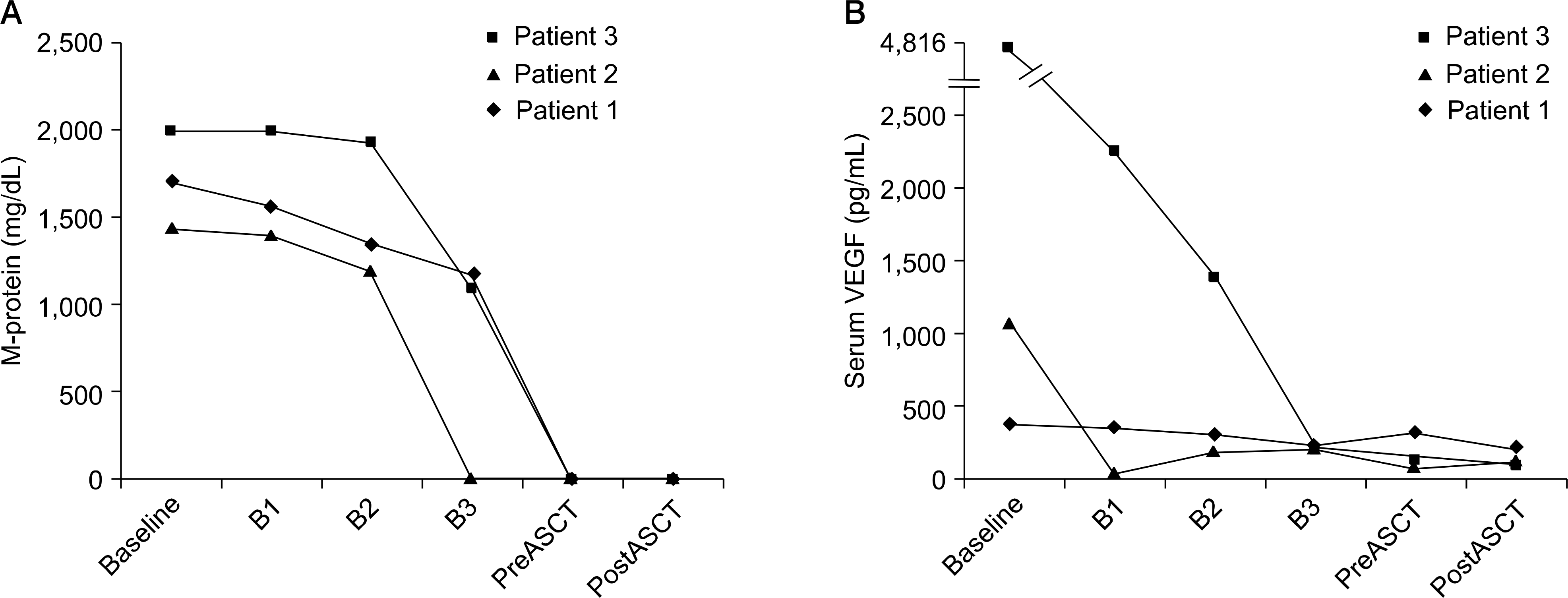Abstract
Background:
The acronym POEMS refers to polyneuropathy, organomegaly, endocrinopathy, M protein, and skin changes. Increased levels of cytokines, including vascular endothelial growth factor (VEGF), appear to play a pathogenic role. POEMS syndrome is progressive and eventually leads to death from neurological problem without therapy.
Methods:
We treated 3 patients affected by POEMS syndrome with front-line bortezomib treatment and the high-dose melphalan with autologous stem cell transplantation (ASCT).
Go to : 
REFERENCES
1). Dispenzieri A., Moreno-Aspitia A., Suarez GA, et al. Peripheral blood stem cell transplantation in 16 patients with POEMS syndrome, and a review of the literature. Blood. 2004. 104:3400–7.

2). Dyck PJ., Engelstand J., Dispenzieri A. Vascular endothelial growth factor and POEMS. Neurology. 2006. 66:10–2.

3). Jagannath S., Durie BG., Wolf J, et al. Bortezomib therapy alone and in combination with dexamethasone for previously untreated symptomatic multiple myeloma. Br J Haematol. 2005. 129:776–83.

4). Hideshima T., Mitsiades C., Akiyama M, et al. Molecular mechanisms mediating antimyeloma activity of proteasome inhibitor PS-341. Blood. 2003. 101:1530–4.

5). Hideshima T., Richardson P., Chauhan D, et al. The proteasome inhibitor PS-341 inhibits growth, induces apoptosis, and overcomes drug resistance in human multiple myeloma cells. Cancer Res. 2001. 61:3071–6.
6). Kastritis E., Anagnostopoulos A., Roussou M, et al. Treatment of light chain (AL) amyloidosis with the combination of bortezomib and dexamethasone. Haematologica. 2007. 92:1351–8.

7). Barlogie B., Anaissie E., van Rhee F, et al. Incorporating bortezomib into upfront treatment for multiple myeloma: early results of total therapy 3. Br J Haematol. 2007. 138:176–85.

8). Anderson KC., Hannah AL., Pazdur R., Farrell AT. A strategic framework for novel drug development in multiple myeloma. Br J Haematol. 2007. 138:153–9.

9). Sinisalo M., Hietaharju A., Sauranen J., Wirta O. Thalidomide in POEMS syndrome: case report. Am J Hematol. 2004. 76:66–8.

10). Gherardi RK., Belec L., Soubrier M, et al. Overproduction of proinflammatory cytokines imbalanced by their antagonists in POEMS syndrome. Blood. 1996. 87:1458–65.

11). BladéJ. Samson D., Reece D, et al. Criteria for evaluating disease response and progression in patients with multiple myeloma treated by high-dose therapy and haemopoietic stem cell transplantation. Myeloma Subcommittee of the EBMT. European Group for Blood and Marrow Transplant. Br J Haematol. 1998. 102:1115–23.
12). Soubrier M., Dubost JJ., Serre AF, et al. Growth factors in POEMS syndrome: evidence for a marked increase in circulating vascular endothelial growth factor. Arthritis Rheum. 1997. 40:786–7.

13). Gherardi RK., Bélec L., Fromont G, et al. Elevated levels of interleukin-1beta (IL-1beta) and IL-6 in serum and increased production of IL-1beta mRNA in lymph nodes of patients with polyneuropathy, organomegaly, endocrinopathy, M protein, and skin changes (POEMS) syndrome. Blood. 1994. 83:2587–93.
14). Sanada S., Ookawara S., Karube H, et al. Marked recovery of severe renal lesions in POEMS syndrome with high-dose melphalan therapy supported by autologous blood stem cell transplantation. Am J Kid Dis. 2006. 47:672–9.

Go to : 
 | Fig. 1Serial changes in serum levels of M-protein (A) and vascular endothelial growth factor (B) following bortezomib treatment and autologuos stem cell transplantation (ASCT). Abbreviations: B1 after 1st chemotherapy, B2 after 2nd chemotherapy and B3 after 3rd chemotherapy, prior to ASCT (preASCT), and after ASCT (postASCT). |
Table 1.
Characteristics of patients with POEMS syndrome




 PDF
PDF ePub
ePub Citation
Citation Print
Print


 XML Download
XML Download